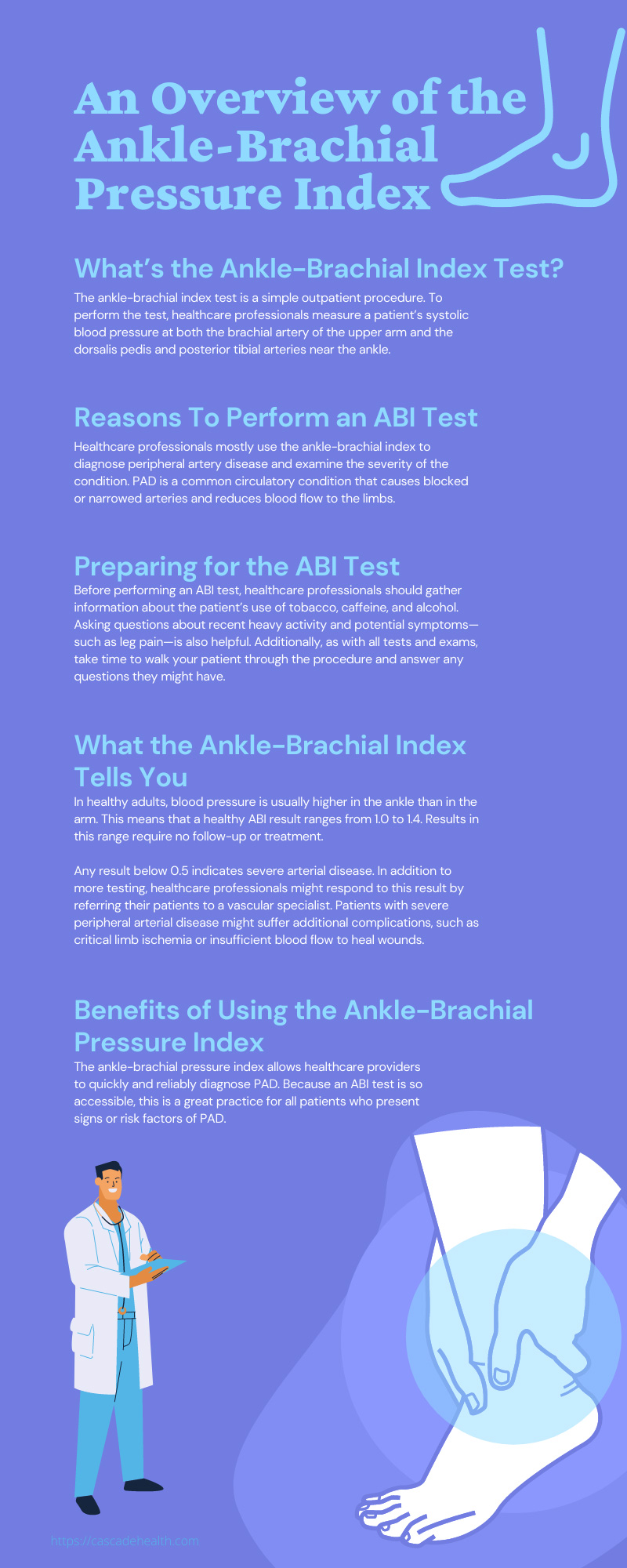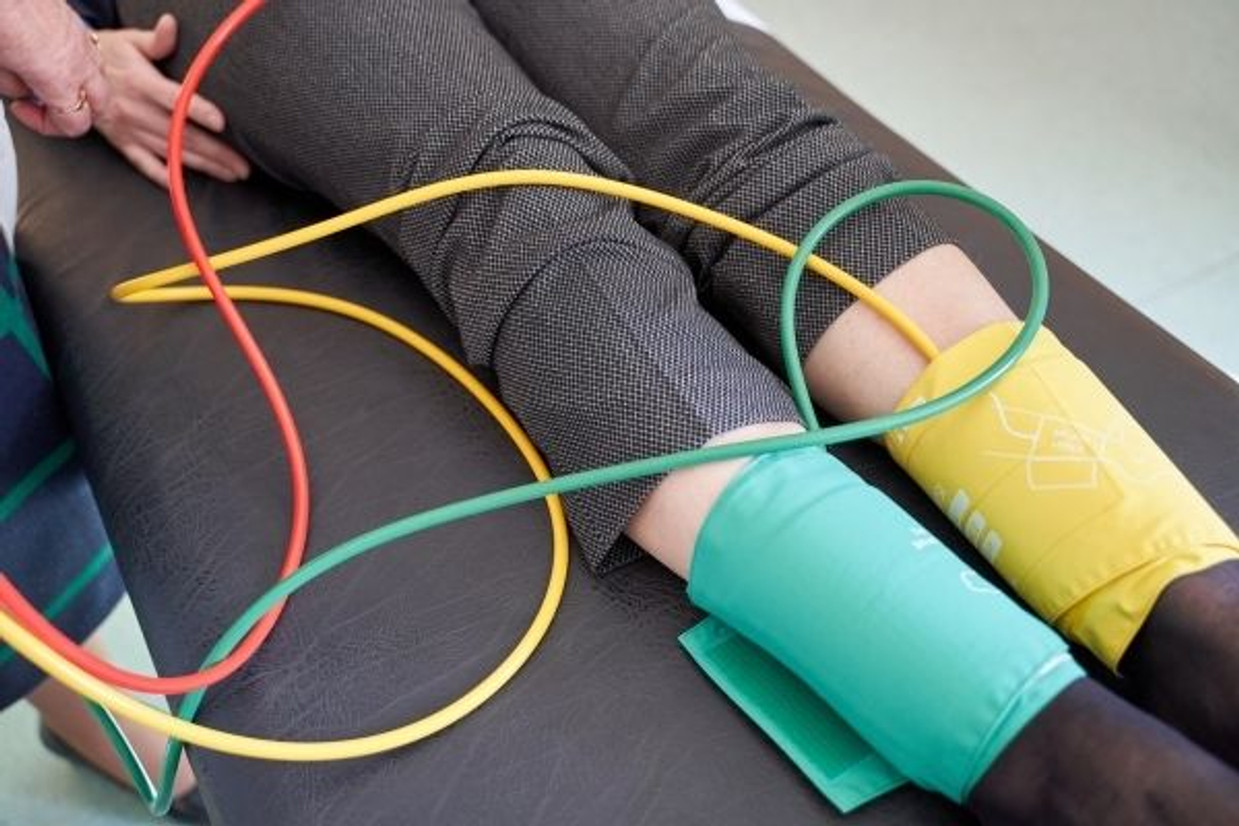An Overview of the Ankle-Brachial Pressure Index
An ankle-brachial pressure index (ABI) test is a fast, straightforward, and non-invasive way to test patients for peripheral artery disease (PAD). Such a simple diagnosis method makes it easy for healthcare professionals to catch the disease early and help their patients find the treatments and healthy habits they need to improve their health.
There are many benefits to performing an ankle-brachial index test. The test is quick, easy, and painless for patients, but the results can help patients commit to healthy habits and lifestyle changes that can preserve their health and improve their quality of living. Explore the uses, methodology, and results of this procedure with this overview of the ankle-brachial pressure index.
What’s the Ankle-Brachial Index Test?
The ankle-brachial index test is a simple outpatient procedure. To perform the test, healthcare professionals measure a patient’s systolic blood pressure at both the brachial artery of the upper arm and the dorsalis pedis and posterior tibial arteries near the ankle. This information provides an accurate metric for diagnosing peripheral artery disease. The ABI test looks for early symptoms and risk factors such as narrowed or blocked arteries in the legs.
This test usually takes place after a patient has been resting for 10-15 minutes, but doctors might also measure blood pressure before and after the patient walks on a treadmill. Measuring blood pressure after this physical activity might improve the sensitivity of the ABI test.
Reasons To Perform an ABI Test
Healthcare professionals mostly use the ankle-brachial index to diagnose peripheral artery disease and examine the severity of the condition. PAD is a common circulatory condition that causes blocked or narrowed arteries and reduces blood flow to the limbs.
The lack of blood flow can cause symptoms like muscle pain, cramps, or numbness or weakness in the limbs. Other indicators of the disease include coldness caused by poor circulation, a change of color in the legs, a weak pulse in the legs or feet, or sores on the toes, feet, and legs. While PAD can affect both arms and legs, it’s more common in the legs. It’s also important to note that many people who have PAD—or are at risk of PAD—have mild symptoms or are asymptomatic.
PAD is often the result of fatty deposits along artery walls. Risk factors including smoking, diabetes, high blood pressure, high cholesterol, and increasing age. Because many patients with PAD are asymptomatic, best practices recommend that healthcare professionals perform the ABI test on patients who fall into these categories. Specifically, the test can greatly benefit patients over 50 who smoke or have diabetes, older patients with a history of high blood pressure or cholesterol, and any patients over the age of 70. It’s also a good idea to perform the test on patients who are experiencing unexplained leg pain while walking.
Preparing for the ABI Test
Before performing an ABI test, healthcare professionals should gather information about the patient’s use of tobacco, caffeine, and alcohol. Asking questions about recent heavy activity and potential symptoms—such as leg pain—is also helpful. Additionally, as with all tests and exams, take time to walk your patient through the procedure and answer any questions they might have.
As you prepare for the test, make sure the patient is resting in the supine position in a warm, quiet environment. ABI results are more accurate when the patient is relaxed and comfortable with an empty bladder. Let the patient rest for at least 10 minutes so that blood pressure can normalize before the test.
A handheld vascular Doppler provides fast and reliable results for the ABI test. Place the cuffs in the appropriate areas on the arm and ankle. Make sure the cuffs are secure with no wrinkles. Before you inflate the cuffs, use the Doppler probe to detect a clear arterial pulse. When the test begins, slowly inflate the cuffs and use the vascular Doppler to measure the systolic blood pressure of each artery.
Repeat the measurements on the opposite leg for more accurate results. Once you’ve recorded all the data you need, you can determine the ABI value by dividing the pressure of the arteries at the ankle by the pressure of the brachial artery. Round this number to two decimal places to find your results on the ankle-brachial index.
What the Ankle-Brachial Index Tells You
This overview of the ankle-brachial pressure index can help you determine whether a patient has PAD and how severe the case is.
In healthy adults, blood pressure is usually higher in the ankle than in the arm. This means that a healthy ABI result ranges from 1.0 to 1.4. Results in this range require no follow-up or treatment.
Similarly, an ABI between 0.9 and 1.0 is acceptable. However, this ABI is on the borderline of peripheral artery disease. It’s a good idea to periodically monitor patients with this result to make sure their ABI stays in an acceptable range.
Any ABI result below 0.9 qualifies as a PAD diagnosis. Patients with an ABI between 0.8 and 0.9 have a minor version of the disease. At this point, healthcare providers should offer treatments and advice to treat risk factors. Examples include regular exercise and quitting any form of tobacco use.
An ABI result between 0.5 and 0.8 indicates moderate arterial disease. At this point, healthcare professionals might suggest additional testing to get more accurate results or view the blocked arteries.
Any result below 0.5 indicates severe arterial disease. In addition to more testing, healthcare professionals might respond to this result by referring their patients to a vascular specialist. Patients with severe peripheral arterial disease might suffer additional complications, such as critical limb ischemia or insufficient blood flow to heal wounds. Healthcare providers should keep these conditions in mind when talking to patients and recommending care for such severe ABI results.
Benefits of Using the Ankle-Brachial Pressure Index
The ankle-brachial pressure index allows healthcare providers to quickly and reliably diagnose PAD. Because an ABI test is so accessible, this is a great practice for all patients who present signs or risk factors of PAD. The earlier doctors and patients know about a patient’s ABI, the easier it is to treat PAD and encourage healthy, preventative behaviors. The ABI test does more than just diagnose PAD, though. This procedure also provides doctors with an indication of the severity of the disease. This allows healthcare providers to offer more personalized treatment and advice to their patients, which in turn makes it easier to achieve better results and improve the wellbeing of your patients.

Recent Posts
-
Exploring Recent Innovations in Doppler Signal Processing
Doppler technology has become an essential diagnostic tool in modern medicine, enabling healthcare p
-
Exploring Recent Innovations in Doppler Signal Processing
Doppler technology has become an essential diagnostic tool in modern medicine, enabling healthcare p


